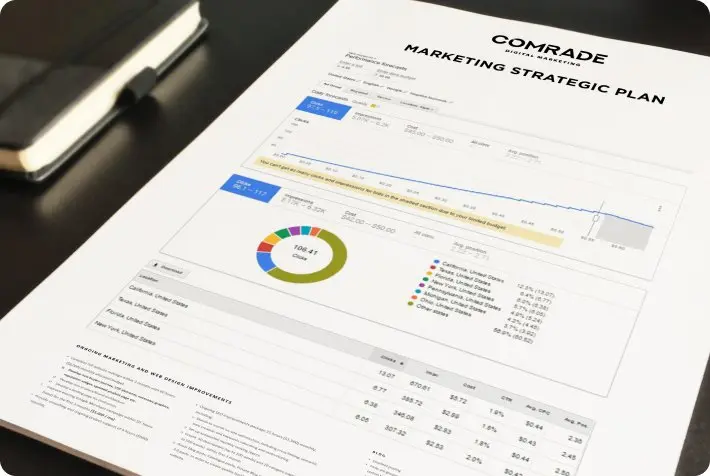Your law degree cost you over $150,000 — are you letting Google give that investment to your competitors for free?
While you’re billing hours and winning cases, potential clients are searching “divorce lawyer near me” or “personal injury attorney in [your city]” — and if you’re not on page one, you’re invisible. After all, 75% of those who use Google don’t bother to scroll past the first page.
But here’s what’s changed: ranking in 2025 isn’t just about keywords and backlinks anymore. Google’s advanced algorithms, which determine website rankings, consider many factors, including content quality, user engagement metrics, link profiles, social media signals, and more. And with AI transforming how people search, your firm needs to master both traditional SEO and the new rules of AI-powered search.
This comprehensive guide breaks down the 10 critical Google ranking factors that distinguish thriving law firms from those that remain invisible. We’ll show you exactly what works in today’s competitive legal landscape — no fluff, just proven strategies that drive real results.
Part of Our SEO Guide for Law Firms
Explore each part of our complete guide to mastering SEO for law firms:

Why Law Firm Rankings Are More Competitive Than Ever
Picture this scenario: A potential client gets served with divorce papers. Their first instinct? Google “divorce lawyer near me.”
Within seconds, they see three law firms in the map pack, a few paid ads, and maybe an AI-generated summary. Your firm? Nowhere to be found. That client — and their $5,000 retainer — just went to someone else.
The Stakes Have Never Been Higher
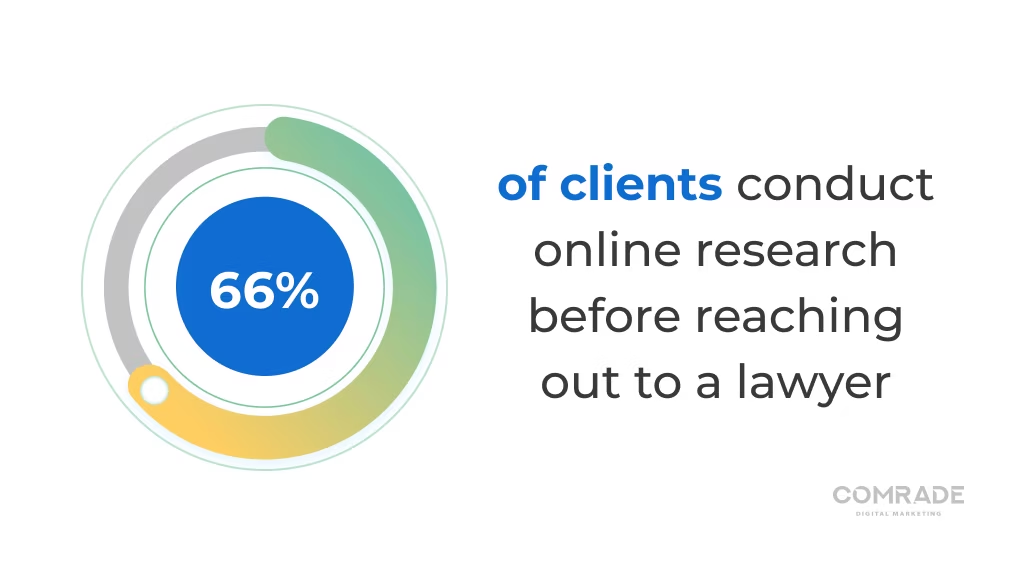
- 66% of clients conduct online research before reaching out to a lawyer
- 28.5% of clicks go to the first organic result
- Position #10 gets just 2.5% of clicks — might as well be invisible
For law firms, this isn’t just about traffic metrics. It’s about real cases, real revenue, and the growth of your practice.
Law Firms Face Unique Ranking Challenges
Google doesn’t treat all websites equally. Legal sites fall under “Your Money or Your Life” (YMYL) standards — meaning Google scrutinizes them harder than a recipe blog or entertainment site.
Why? Because bad legal advice can ruin lives. Google knows this, and its algorithm reflects it.
The Algorithm Has Evolved (Again)
Five years ago, you could stuff keywords into a page and watch it climb. Today? Google’s AI understands context, evaluates expertise, and even predicts what users want, not just what they typed.
RankBrain, BERT, and now AI Overviews have fundamentally changed how Google interprets searches. The firms winning today understand these changes and align their content accordingly.
Ready to see what moves the needle? Let’s dive into the ranking factors that matter most.
1. High-Quality, Informative Content
In the past, a 300-word service page could suffice to rank well. Today, however, Google’s algorithm rewards depth, precision, and authentic value—especially in the realm of content marketing for lawyers.
What Google Considers “High Quality” for Law Firms
Content quality isn’t subjective anymore. Google’s quality raters follow specific guidelines, and for YMYL topics like legal advice, the bar is exceptionally high. The algorithm looks for comprehensive coverage that demonstrates real expertise, not surface-level explanations that anyone could write.
Studies show that the average first-page result contains 1,447 words. But word count alone doesn’t equal quality — it’s about thoroughly answering the searcher’s question and related concerns they haven’t even thought of yet.
Why Informative Content Ranks Higher
Google’s primary goal is to satisfy user intent.
When someone searches “what happens at a DUI arraignment,” they want specifics — timelines, procedures, potential outcomes, and next steps. Thin content that glosses over these details sends users back to search results, signaling to Google that your page didn’t deliver.
The algorithm tracks user behavior signals like dwell time and bounce rate. Pages that keep users engaged and prevent them from returning to search results get rewarded with higher rankings.
The E-E-A-T Factor in Legal Content
For law firms, Experience, Expertise, Authoritativeness, and Trustworthiness (E-E-A-T) aren’t optional — it’s essential. Google evaluates whether your content demonstrates:
- Experience: Real-world legal practice and case handling
- Expertise: Deep knowledge of specific practice areas
- Authoritativeness: Recognition from peers and clients
- Trustworthiness: Accurate, ethical, and reliable information
Pages that display attorney credentials, case results, and professional affiliations send strong E-E-A-T signals that boost rankings.
2. Strategic Backlink Building & Off-Page SEO
Backlinks remain a cornerstone of Google’s ranking system, but for law firms, the emphasis should be on quality over quantity. Google’s algorithm evaluates the relevance, authority, and context of every link, linking building for law firms a strategic necessity.
Why Backlinks Still Dominate Ranking Factors
Think of backlinks as votes of confidence. When the State Bar website links to your firm, Google sees that as a powerful endorsement. When a local news outlet quotes you as a legal expert, that’s another trust signal.
Research from Ahrefs found that 96.55% of pages get zero organic traffic, and the number one reason is the lack of backlinks. Pages in position #1 have an average of 3.8x more backlinks than positions #2-#10.
The Authority Transfer Principle
Not all links carry equal weight. Google’s PageRank algorithm (yes, it’s still a factor) evaluates the linking page’s authority and passes a portion to your site. A link from Harvard Law Review carries more ranking power than 100 links from random blogs.
The algorithm also considers topical relevance. Legal directories, bar associations, and law school sites provide stronger signals than general business directories because they’re topically aligned with your content.
Off-Page Signals Beyond Links
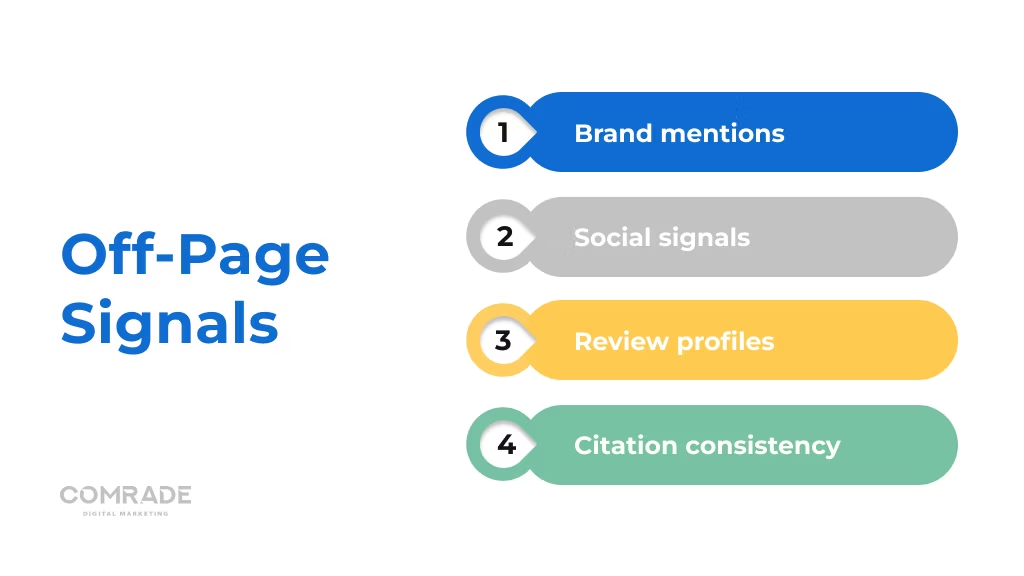
Modern off-page SEO encompasses more than traditional link building. Google’s algorithm now factors in:
- Brand mentions (even without links)
- Social signals and engagement
- Review profiles across platforms
- Citation consistency across the web
These signals work together to establish your firm’s digital footprint and influence rankings across all your pages.
3. Local SEO Optimization for Law Firms
Local SEO for law firms is all about local ranking factors that often trump traditional SEO signals. When a potential client types “personal injury lawyer near me,” Google’s local algorithm takes control, running on a completely different set of rules.
The Local Pack Algorithm
Google’s local search algorithm weighs three primary factors: relevance, distance, and prominence. But here’s what most firms miss — these factors interact in complex ways.
A firm 10 miles away with strong local signals can outrank a competitor next door with weak optimization. Studies indicate that local pack results get 33% of clicks for local searches, making these three spots incredibly valuable.
Google Business Profile as a Ranking Signal
Your law firm’s Google Business Profile isn’t just a listing — it’s a powerful ranking factor. The algorithm evaluates:
- Completeness of information (categories, attributes, hours)
- Engagement metrics (clicks, calls, direction requests)
- Review quantity and velocity
- Photo uploads and views
- Post-frequency and interaction
Firms with optimized GBP listings see an average 70% increase in calls and directions requests.
Local Citation Influence
Consistent NAP (Name, Address, Phone) data across the web acts as a trust signal for Google’s local algorithm. Major data aggregators like Neustar and Foursquare feed information to hundreds of platforms, creating a web of citations that Google crawls to verify your firm’s legitimacy.
The algorithm cross-references this data to establish confidence in your location and service area. Inconsistencies create doubt and can suppress local rankings.
4. Mobile Optimization and Responsiveness
Since 2019, mobile-first indexing has been a game-changer, and for law firms, it’s no longer optional. With 60% of Google searches happening on mobile devices, ensuring your law firm’s site is optimized for mobile is key to having one of the best lawyer websites.
How Mobile-First Indexing Works
Google predominantly uses the mobile version of your site for indexing and ranking. This means if your mobile site is stripped down or poorly optimized, that’s what Google judges, regardless of how impressive your desktop version looks.
The algorithm evaluates mobile usability through multiple lenses: responsive design, touch-friendly navigation, readable text without zooming, and proper spacing between clickable elements.
Mobile Page Experience Signals
Google’s Page Experience update made mobile performance a direct ranking factor. The algorithm measures:
- Largest Contentful Paint (LCP): How fast the main content loads
- First Input Delay (FID): How quickly the page responds to interaction
- Cumulative Layout Shift (CLS): Visual stability as the page loads
Sites failing these Core Web Vitals see measurable ranking drops. Google’s data shows users are 24% less likely to abandon sites that meet all thresholds.
The Mobile Conversion Factor
While not a direct ranking signal, mobile conversion rates influence user behavior metrics that Google does track. Law firms with mobile-optimized contact forms and click-to-call buttons keep users engaged longer, sending positive signals back to the algorithm.
5. Site Speed and Performance Enhancement
In SEM for attorneys, speed isn’t just a nice-to-have — it’s a critical ranking factor. For law firms competing in highly competitive markets, milliseconds can separate a top ranking from a secondary one, making all the difference between page one and page two.
Why Google Prioritizes Speed
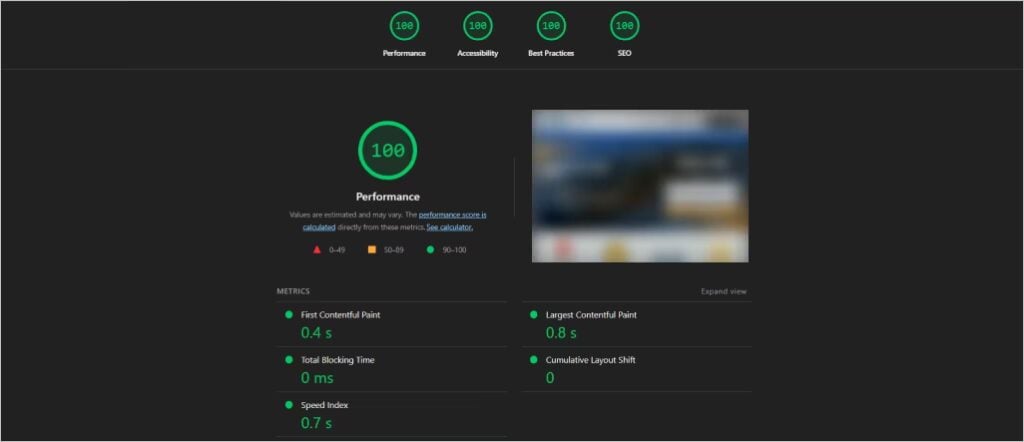
The data is stark: 53% of mobile users abandon sites that take over 3 seconds to load. Google knows this, which is why site speed became a ranking factor for desktop searches in 2010 and mobile searches in 2018.
But it goes deeper than user satisfaction. Fast sites consume less bandwidth, use fewer server resources, and provide better accessibility for users on slower connections — all priorities for Google’s infrastructure.
Core Web Vitals Impact
Google’s Core Web Vitals quantify the user experience through three specific metrics:
- Pages meeting all thresholds see a 70% increase in user engagement
- Improving LCP by 2.5 seconds correlates with 0.8% higher conversion rates
- Sites with poor CLS scores see 25% higher bounce rates
The algorithm doesn’t just measure your homepage — it evaluates speed across your entire site, with particular attention to high-traffic pages.
The Compound Effect of Performance
Site speed influences other ranking factors, too. Faster sites typically have:
- Lower bounce rates (positive user signal)
- Higher pages per session (engagement signal)
- Better crawl efficiency (more pages indexed)
- Improved mobile usability scores
This creates a compound effect where speed improvements boost multiple ranking factors simultaneously.
6. Comprehensive On-Page SEO Best Practices
Effective on-page SEO for lawyers is essential in helping Google understand and rank your content accurately. For law firms, optimizing on-page elements can be the key factor in ranking for specific search terms, such as “lawyer” versus “personal injury lawyer in Chicago.”
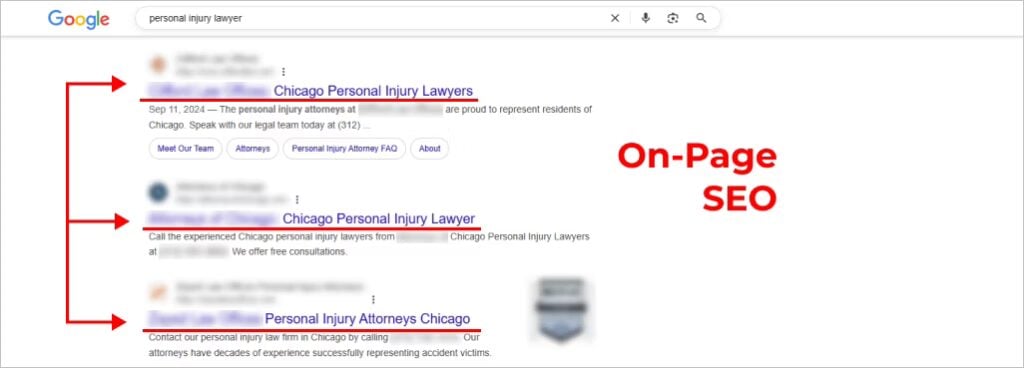
Title Tags and Ranking Correlation
Title tags carry significant ranking weight — they’re often the first thing Google’s crawler reads. Studies show that pages with keywords in the title tag are 2.5x more likely to rank on page one.
But the algorithm has evolved beyond exact matches. Google now understands synonyms, related terms, and search intent. A title like “Chicago Car Accident Attorney | Free Consultation” performs better than keyword-stuffed alternatives because it balances optimization with user appeal.
The Heading Hierarchy Signal
Google’s algorithm uses heading tags (H1, H2, H3) to understand content structure and topical relevance. Proper heading hierarchy acts like an outline, helping the crawler identify main topics and subtopics.
Pages with clear heading structures see higher average rankings because they:
- Signal content organization to crawlers
- Improve content accessibility
- Enhance featured snippet eligibility
- Boost passage ranking potential
Meta Descriptions and Click-Through Impact
While meta descriptions aren’t a direct ranking factor, they heavily influence click-through rates, which Google does monitor. A compelling meta description can improve CTR by 5.8%, sending positive user signals that boost rankings over time.
Internal Linking Architecture
Internal links distribute ranking power throughout your site while helping Google understand topical relationships. Law firms with strategic internal linking see:
- Improved crawl efficiency
- Better topical authority signals
- Lower bounce rates
- Increased pages per session
The algorithm evaluates both the quantity and quality of internal links, favoring contextually relevant connections over forced linking.
7. User Experience (UX) and Navigation
Google’s algorithm has evolved to better assess user satisfaction, making it more important than ever for law firms to focus on user experience. For solo lawyer websites, UX goes beyond aesthetics—it’s a critical ranking factor that influences online visibility.
Understanding User Behavior Signals
Google tracks how users interact with your site through various metrics:
- Dwell time: How long do users stay on your page
- Bounce rate: Single-page sessions without interaction
- Pogo-sticking: Users quickly return to search results
- Click-through rate: How often your result gets clicked
These behavioral signals inform the algorithm about content quality and relevance. Pages with poor user experience metrics consistently rank lower over time.
Navigation Structure as a Ranking Signal
Clear, logical navigation helps both users and crawlers understand your site structure. Google’s algorithm favors sites with:
- Shallow click depth (important pages within 3 clicks)
- Breadcrumb navigation implementation
- Clear menu hierarchies
- Logical URL structures
Research indicates that improved navigation can reduce bounce rates by up to 30% — a powerful positive signal for rankings.
The Accessibility Factor
Google increasingly prioritizes accessible websites. The algorithm evaluates:
- Proper heading structure for screen readers
- Alt text for images
- Sufficient color contrast
- Keyboard navigation capability
Sites meeting WCAG 2.1 AA standards typically see better engagement metrics and, consequently, improved rankings.
8. Client Reviews and Online Reputation Management
For law firms, reviews are more than just social proof; they’re a critical ranking factor that Google’s algorithm prioritizes, especially for local searches, making attorney review sites essential.
Review Signals in Google’s Algorithm
Google’s local algorithm specifically factors in:
- Review quantity: Total number across platforms
- Review velocity: Frequency of new reviews
- Review diversity: Distribution across different platforms
- Response rate: How often do you engage with reviews
- Keyword relevance: Legal terms mentioned in reviews
Studies show that businesses with 4+ stars see 2.5x more clicks than those below 3 stars — and Google notices these engagement patterns.
The Trust Factor
Reviews contribute to your firm’s E-E-A-T signals. When clients consistently mention successful case outcomes, professional service, or specific practice areas, these natural language patterns reinforce your topical authority.
Google’s sentiment analysis has become sophisticated enough to understand context. Detailed reviews mentioning “helped with my DUI case” or “excellent personal injury attorney” carry more weight than generic five-star ratings.
Platform Authority Weighting
Not all review platforms carry equal weight. Google appears to prioritize:
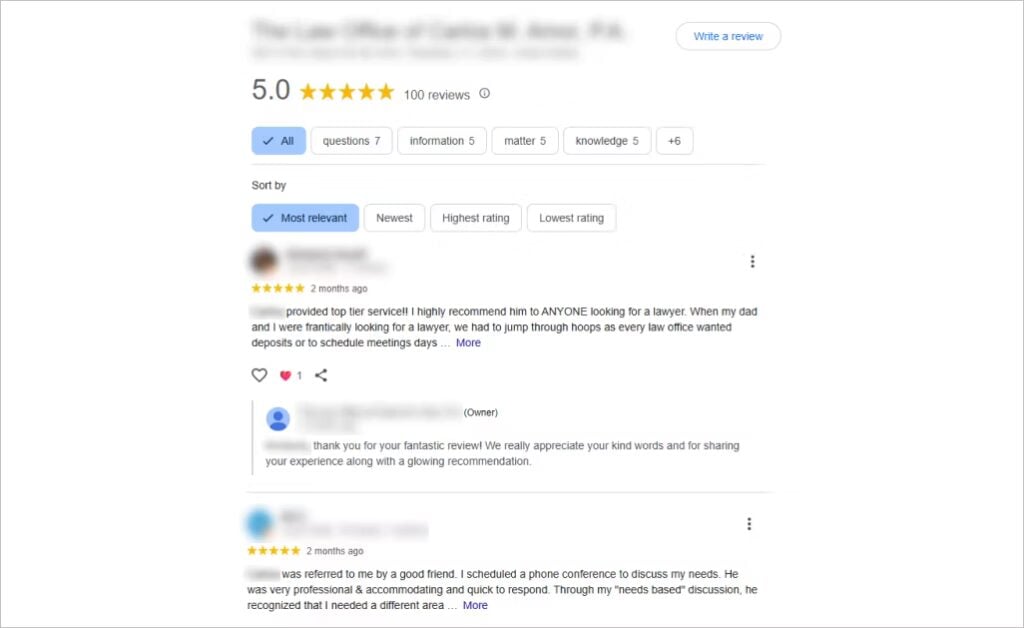
- Google Reviews (highest weight for local rankings)
- Industry-specific platforms (Avvo, Martindale-Hubbell)
- Major aggregators (Yelp, Facebook)
- BBB accreditation and ratings
The algorithm cross-references reviews across platforms to establish consistency and authenticity.
9. Structured Data and Schema Markup Implementation
Structured data helps Google’s algorithm understand your content beyond just keywords. For law firms, proper schema implementation can be the difference between a standard listing and a rich result that dominates the SERP.
How Schema Influences Rankings
While Google states that structured data isn’t a direct ranking factor, it significantly impacts how your content appears in search results. Pages with proper schema markup are:
- 2.5x more likely to appear in rich results
- Eligible for enhanced SERP features
- Better understood by AI-powered search systems
- More likely to match specific search intents
Critical Schema Types for Law Firms
Google’s algorithm recognizes specific schema types that apply to legal services:
- LocalBusiness/Attorney: Establishes your firm’s identity
- Review/AggregateRating: Displays star ratings in results
- FAQPage: Enables FAQ rich snippets
- Article: Helps legal blog content stand out
- Person: Highlights individual attorney expertise
Proper implementation sends clear signals about your content type and purpose, improving matching for relevant queries.
The AI Search Advantage
As Google’s search becomes more AI-driven, structured data becomes even more critical. AI systems use schema to:
- Extract key information for featured snippets
- Generate accurate AI overviews
- Understand entity relationships
- Match voice search queries
Law firms with comprehensive schema implementation see 11% higher click-through rates on average.
10. Social Signals and Their Impact on SEO
While Google downplays the role of social signals in ranking, the link between social media engagement and improved search rankings is irrefutable. For law firms, effective social media marketing for lawyers can positively affect several ranking factors that Google prioritizes.
The Indirect Ranking Influence
Social signals impact rankings through multiple pathways:
- Brand awareness: Increased searches for your firm name
- Content amplification: Wider reach leads to more backlinks
- Engagement metrics: Social traffic often has positive user signals
- Freshness signals: Active social presence indicates current operation
Research shows that pages with high social engagement tend to rank 2.2x better than those without, suggesting a strong indirect influence.
Platform Authority and Trust
Google can identify and evaluate your firm’s presence across major platforms. Verified profiles on LinkedIn, Facebook, and X (Twitter) contribute to:
- Entity Recognition in Knowledge Graph
- Brand authority signals
- Consistency verification across the web
- Professional credibility indicators
The Content Distribution Effect
Social sharing accelerates content discovery, leading to:
- Faster indexing of new content
- Increased likelihood of earning natural backlinks
- Higher traffic volumes (a positive user signal)
- Greater brand mention frequency
While likes and shares themselves don’t boost rankings, the downstream effects create multiple positive signals that Google’s algorithm does value.
The Bottom Line: Your Expertise Deserves to Be Found
To wrap things up, optimizing for Google’s ranking factors is critical for law firms looking to succeed in today’s competitive digital space. Every detail, from the technical SEO health of your site to the quality of your content and local SEO efforts, contributes to boosting your visibility and attracting more clients.
At Comrade Digital Marketing, we specialize in creating customized SEO strategies that drive real results. Our team is always on top of the latest Google algorithm updates, ensuring your law firm stays ahead of the curve and consistently ranks higher in search results.
Whether you’re aiming to fix technical issues, improve your content, or enhance your local SEO, we’ve got the expertise to help your firm rise above the competition. Together, we can build a stronger online presence that generates more leads and grows your client base.
Ready to take your law firm’s digital marketing to the next level? Book a consultation with us today, and let’s explore how we can help you achieve lasting success!
Frequently Asked Questions
-
In what ways do meta tags impact SEO performance?
Meta tags help web pages communicate relevance to search engines, directly influencing how content appears in search engine results pages. Properly optimized meta titles and descriptions can improve click-through rates, which indirectly benefits SEO ranking.
-
What is the importance of Google My Business (GMB) for law firms?
Google My Business is essential for law firms because it enhances visibility on mobile devices and local maps, especially for clients searching nearby. It also integrates with Google Analytics to track user interactions and optimize local engagement.
-
How does Google’s algorithm update affect law firm SEO?
Google’s algorithm updates reshape important ranking factors, affecting how law firms must structure content and technical elements to remain competitive. Monitoring changes through Google Search Console allows quick adaptation to maintain search visibility.
-
What role does an SSL certificate play in SEO?
An SSL certificate builds trust and protects user data, both of which are now part of core web vitals. Secured sites are favored in rankings, especially when accessed from mobile devices.
